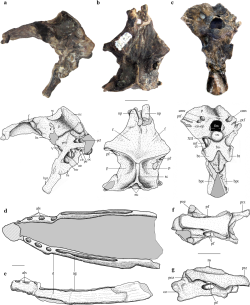Allkaruen
|
Allkaruen Temporal range: Early Jurassic - Middle Jurassic, 182–168 Ma |
|
|---|---|
 |
|
| Skeletal elements | |
| Scientific classification | |
| Kingdom: | Animalia |
| Phylum: | Chordata |
| Class: | Reptilia |
| Order: | †Pterosauria |
| Genus: |
†Allkaruen Codorniú et al., 2016 |
| Species: | †A. koi |
| Binomial name | |
|
Allkaruen koi Codorniú et al., 2016 |
|
Allkaruen (meaning "ancient brain") is a genus of rhamphorhynchoid pterosaur from the Early-to-Middle Jurassic Cañadon Asfalto Formation in Argentina. It contains a single species, A. koi.
As demonstrated by a CT scan, the braincase of Allkaruen exhibits a unique set of traits that are intermediate between more basal pterosaurs such as Rhamphorhynchus and more derived pterodactyloid pterosaurs such as Anhanguera. These traits are the position of the anterior semicircular canal of the inner ear, the relative orientations of the occiput and occipital condyle, the relative positions of the lateral margins of the flocculus and cerebral hemispheres, and the ratio between the length of the brain and the height of the hindbrain. In addition, the relative orientations of the frontal bone and lateral semicircular canal are more similar to Rhamphorhynchus than Anhanguera, while the optic lobes are positioned lower than the forebrain as in pterodactyloids. This unique combination of characters indicates that the anatomy of the braincase in pterodactyloids evolved through mosaic evolution.
The parietals of Allkaruen were long, being 60% of the length of the frontals; the frontals themselves were broad, flat, and extensively pneumatized. The lower jaw was about 3.5 times the length of the section of the skull that is preserved, and it is curved upwards at its tip. The dentary bore four or five tooth sockets in its front half, and in the latter half they were replaced by a groove; this combination is unique among pterosaurs.
...
Wikipedia
